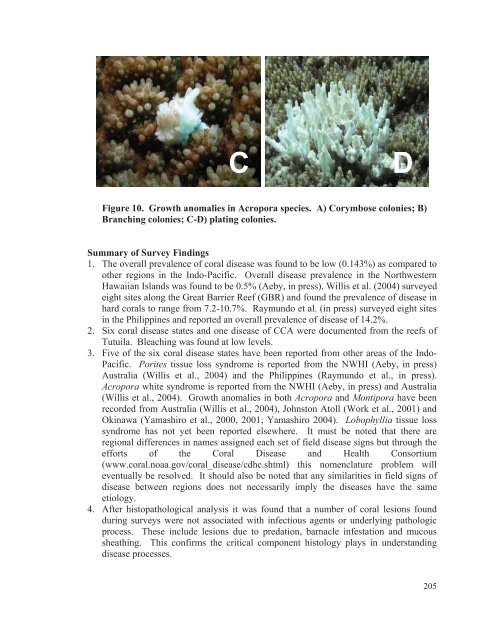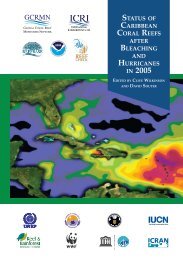- Page 5:
TABLE OF CONTENTSTABLE OF FIGURES
- Page 10 and 11:
Though the proliferation of coral r
- Page 12:
years. Recent surveys conducted in
- Page 18 and 19:
priority right now. What’s I have
- Page 23 and 24:
As an initial step to identify and
- Page 25 and 26:
The four working groups identified
- Page 27 and 28:
able to understand the normal struc
- Page 29 and 30:
In the following section the PPWG i
- Page 31 and 32:
subspecies, thus limiting the abili
- Page 33 and 34:
(Baird and Babcock 2000; Muscatine
- Page 35 and 36:
(Yakovleva and Hidaka 2004). In an
- Page 37 and 38:
y disulfides (Richards et al. 1983)
- Page 39 and 40:
species of Octocorallia were report
- Page 41 and 42:
h. Availability and Processes for o
- Page 43 and 44:
Understanding of conditions that su
- Page 45 and 46:
Physiology & Pathology Working Grou
- Page 47 and 48:
Boehm et al. 1995b; Downs et al. 20
- Page 49 and 50:
B. Overall Strategic Objective: Imp
- Page 51 and 52:
Table B.1 CORAL HEALTH/DISEASE INDI
- Page 53 and 54:
Strategic Objective B.2: Establish
- Page 55 and 56:
Table B.3 INDICATORS OF CORAL HEALT
- Page 57 and 58:
Table B.4 IDENTIFICATION OF RISK FA
- Page 59 and 60:
Table B.4 IDENTIFICATION OF RISK FA
- Page 61 and 62:
Assess potential reporting requirem
- Page 63 and 64:
Figure B.2 Integrated Framework for
- Page 65 and 66:
Challenges and Recommendations:The
- Page 67 and 68:
Strategic Objective C.2: Develop a
- Page 69 and 70:
on hold until specific guidelines c
- Page 71 and 72:
Pathology of Disease Working Group
- Page 73 and 74:
General efforts to mitigate anthrop
- Page 75 and 76:
Challenges and RecommendationsThere
- Page 77 and 78:
d. Identifying and mitigating manag
- Page 79 and 80:
Strategic Objective D.1: Enhance th
- Page 81 and 82:
known to be affected by specific co
- Page 83 and 84:
A variety of natural and anthropoge
- Page 85 and 86:
Recommendation D.3.2: Develop local
- Page 87 and 88:
Strategic Objective D.4: Identify p
- Page 89 and 90:
Management Perspectives Working Gro
- Page 91 and 92:
I. INTRODUCTION—SETTING THE STAGE
- Page 93 and 94:
more difficult to design management
- Page 95 and 96:
Specialized ResourcesSeveral specia
- Page 97 and 98:
STUDYING CORAL DISEASES; UNDERSTAND
- Page 99 and 100:
egional decline of Acropora. Report
- Page 101 and 102:
distributional maps. The GCDD inclu
- Page 103 and 104:
Table 1. Diseases, syndromes, abnor
- Page 105 and 106:
In a review article, Sutherland et
- Page 107:
Table 2. Various white syndromes re
- Page 110 and 111:
Dark spots disease was first observ
- Page 112 and 113:
Table 4. Other Diseases, syndromes,
- Page 114 and 115:
Fig. 1. Five major scleractinian co
- Page 116 and 117:
Fig. 3. Number of diseases observed
- Page 118 and 119:
ReferencesAbbott, R.E. 1979. Ecolog
- Page 120 and 121:
Bythell, J.C., M.R. Barer, R.P. Coo
- Page 122 and 123:
Friends of the Virgin Islands Natio
- Page 124 and 125:
Knowlton, N. , J.C. Lang, M.C. Roon
- Page 126 and 127:
Peters E.C., J.C. Halas, and H.B. M
- Page 128 and 129:
Rutzler, K., D.L. Santavy, and A. A
- Page 130 and 131:
WORLD BANK PROJECT: CORAL DISEASE W
- Page 132 and 133:
Impact of fish farmsAs part of its
- Page 134 and 135:
III. HISTORICAL PERSPECTIVE--LESSON
- Page 136 and 137:
overgrowing corals, and may prevent
- Page 138 and 139:
agents have been proposed for sever
- Page 140 and 141:
photosynthesis pigments. This inclu
- Page 142 and 143:
located predominantly at the axial
- Page 144 and 145:
Syndrome Diagnostics ReferenceYBDDS
- Page 146 and 147:
The average prevalence of coral dis
- Page 148 and 149:
A more virulent form of WP (WP-II)
- Page 150 and 151:
Table 2. Prevalence, incidence and
- Page 152 and 153:
coralicida; Denner et al., 2003) ba
- Page 154 and 155:
Table 3. Causative agents and assoc
- Page 156 and 157:
to areas where human activities hav
- Page 158 and 159:
What have we learned from Caribbean
- Page 160 and 161:
Condition Synonyms Host range Sourc
- Page 162 and 163: ReferencesAbbott, R.E. 1979. Ecolog
- Page 164 and 165: Croquer, A., C. Bastidas and L. Lip
- Page 166 and 167: Smith, and G. R. Vasta. 1999. Emerg
- Page 168 and 169: Richardson, L.L., and K.G. Kuta, 20
- Page 170 and 171: IV. STATE OF KNOWLEDGE IN THE PACIF
- Page 172 and 173: Fisheries:These great expanses of t
- Page 174 and 175: not under the U.S. flag have other
- Page 176 and 177: BASELINE LEVELS OF CORAL DISEASE IN
- Page 178 and 179: INTRODUCTIONFrench Frigate Shoals (
- Page 180 and 181: linear bands of unidentified granul
- Page 182 and 183: The mesoglea formed an arching stru
- Page 184 and 185: # ###R27####NC#R29## #R31#####TC1 R
- Page 186 and 187: 178Figure 3. P. duerdeni. Note clea
- Page 188 and 189: Figure 4. M. capitata, note growth
- Page 190 and 191: Figure 5. P. lobata (A-D). Note clu
- Page 192 and 193: Figure 6. P. lobata (A-H). Coral wi
- Page 194 and 195: Figure 7. A. cytherea (A-D). Type 1
- Page 196 and 197: Figure 8. Blue-gray zooanthid (A-D)
- Page 198 and 199: Report 1. CORAL AND CRUSTOSE CORALL
- Page 200 and 201: Table 1. Coordinates of sites surve
- Page 202 and 203: Based on colony counts within trans
- Page 204 and 205: Histology (gross and microscopic fi
- Page 206 and 207: Figure 2. A) Goniastrea sp. with ba
- Page 208 and 209: Fish bites: This was manifested by
- Page 210 and 211: ABCFigure 7. A-B) Plating Acropora
- Page 214 and 215: 5. There were differences in preval
- Page 216 and 217: Appendix I. Summary of coral lesion
- Page 218 and 219: Acropora Growth AnomaliesHistology:
- Page 220 and 221: Lobophyllia tissue loss syndromeHis
- Page 222 and 223: Report 2. JOHNSTON ATOLL REEF HEALT
- Page 224 and 225: Six locations were selected for spo
- Page 226 and 227: nematocyst). Other mesenteric filam
- Page 228 and 229: atrophied epithelium and absence of
- Page 230 and 231: Seapy 1998). Given the simple anato
- Page 232 and 233: Conference, Heron Island October. S
- Page 234 and 235: Figure 3: Dominant species of coral
- Page 236 and 237: ABCDEFFigure 5. A. cytherea. A) Pur
- Page 238 and 239: ABCDEFFigure 7. A-B) A. cytherea; D
- Page 240 and 241: Figure 9. Number of lesions in A. c
- Page 242 and 243: CORAL DISEASE ON THE GREAT BARRIER
- Page 244 and 245: incidence is changing through time
- Page 246 and 247: populations of ciliates, packed wit
- Page 248 and 249: Unusual bleaching patterns: Distinc
- Page 250 and 251: V. PATHOLOGY AND EPIDEMIOLOGYDISEAS
- Page 252 and 253: EVOLUTIONARY ECOLOGY AND DISEASE EM
- Page 254 and 255: For the reasons outlined above, eme
- Page 256 and 257: WILDLIFE DISEASE INVESTIGATIONS 101
- Page 258 and 259: animals, the leaves were the same b
- Page 260 and 261: examination by a state diagnostic l
- Page 262 and 263:
In the spring of 2003 large numbers
- Page 264 and 265:
VI. COMMUNICATION TO MAKE A DIFFERE
- Page 266 and 267:
An “Ecoplex” conceptual framewo
- Page 268 and 269:
Low stakeholder trust: defensive pa
- Page 270 and 271:
skill level for in situ determinati
- Page 272 and 273:
LEVERAGING POST-GENOMIC TOOLS AND S
- Page 274 and 275:
ACKNOWLEDGEMENTSWe would like to ac
- Page 276 and 277:
grateful to the Working Group Chair
- Page 278 and 279:
Baird, A. H., and P. A. Marshall. 2
- Page 280 and 281:
Dizon, R. M., and H. T. Yap. 2006a.
- Page 282 and 283:
Hayakawa, H., T. Andoh, and T. Wata
- Page 284 and 285:
Kumar, V., A. Abbas, and N. Fausto
- Page 286 and 287:
Permata, W. D., and M. Hidaka. 2005
- Page 288 and 289:
Santavy, D. and others 2001. Quanti
- Page 290 and 291:
Wilkinson, C. 2002. Status of coral
- Page 292 and 293:
Appendix I. Meeting AgendaCORAL HEA
- Page 294 and 295:
7:30 Dinner - Grand Salon Moana Sur
- Page 296 and 297:
genomic tools, including the curren
- Page 298 and 299:
Appendix III. Coral Model Species S
- Page 300 and 301:
Melissa BosMelissa joined the Allia
- Page 302 and 303:
SUNY College of Environmental Scien
- Page 304 and 305:
collaboration between the College o
- Page 306 and 307:
Jo-Ann LeongJo-Ann is Director of t
- Page 308 and 309:
Amanda McLenonAmanda is currently w
- Page 310 and 311:
Technical Advisory Committee on Lan
- Page 312 and 313:
Meir SussmanMeir recently completed
- Page 314 and 315:
Dana WilliamsDana earned her doctor
- Page 316 and 317:
Cheryl WoodleyCheryl received her P
- Page 318 and 319:
Qing Xiao LiUniversity of Hawaii195
- Page 320 and 321:
Appendix VI.OPINION PAPER:Transmiss
- Page 322 and 323:
314
















